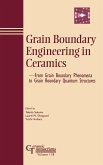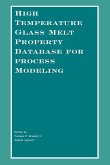- Broschiertes Buch
- Merkliste
- Auf die Merkliste
- Bewerten Bewerten
- Teilen
- Produkt teilen
- Produkterinnerung
- Produkterinnerung
A step-by-step guide on how to use and interpret phase diagrams. Whether used as a textbook or a reference source, this book is the most thorough and complete tool available for users of phase information.
Andere Kunden interessierten sich auch für
![Ceramics and Civilization, Volume VII Ceramics and Civilization, Volume VII]() Ceramics and Civilization, Volume VII183,99 €
Ceramics and Civilization, Volume VII183,99 €![Grain Boundary Engineering in Ceramics Grain Boundary Engineering in Ceramics]() Grain Boundary Engineering in Ceramics151,99 €
Grain Boundary Engineering in Ceramics151,99 €![Advances in Joining of Ceramics Advances in Joining of Ceramics]() Advances in Joining of Ceramics151,99 €
Advances in Joining of Ceramics151,99 €![Mechanical Properties and Performance of Engineering Ceramics and Composites III, Volume 28, Issue 2 Mechanical Properties and Performance of Engineering Ceramics and Composites III, Volume 28, Issue 2]() Edgar Lara-CurzioMechanical Properties and Performance of Engineering Ceramics and Composites III, Volume 28, Issue 2150,99 €
Edgar Lara-CurzioMechanical Properties and Performance of Engineering Ceramics and Composites III, Volume 28, Issue 2150,99 €![Advances in Bioceramics and Biocomposites II, Volume 27, Issue 6 Advances in Bioceramics and Biocomposites II, Volume 27, Issue 6]() Andrew Wereszczak / Edgar Lara-Curzio / Mineo Mizuno (eds.)Advances in Bioceramics and Biocomposites II, Volume 27, Issue 6151,99 €
Andrew Wereszczak / Edgar Lara-Curzio / Mineo Mizuno (eds.)Advances in Bioceramics and Biocomposites II, Volume 27, Issue 6151,99 €![68th Conference on Glass Problems, Volume 29, Issue 1 68th Conference on Glass Problems, Volume 29, Issue 1]() 68th Conference on Glass Problems, Volume 29, Issue 1123,99 €
68th Conference on Glass Problems, Volume 29, Issue 1123,99 €![High Temperature Glass Melt Property Database for Process Modeling High Temperature Glass Melt Property Database for Process Modeling]() High Temperature Glass Melt Property Database for Process Modeling212,99 €
High Temperature Glass Melt Property Database for Process Modeling212,99 €-
-
-
A step-by-step guide on how to use and interpret phase diagrams. Whether used as a textbook or a reference source, this book is the most thorough and complete tool available for users of phase information.
Hinweis: Dieser Artikel kann nur an eine deutsche Lieferadresse ausgeliefert werden.
Hinweis: Dieser Artikel kann nur an eine deutsche Lieferadresse ausgeliefert werden.
Produktdetails
- Produktdetails
- Verlag: Wiley
- Seitenzahl: 176
- Erscheinungstermin: 2. Januar 1984
- Englisch
- Abmessung: 280mm x 210mm x 9mm
- Gewicht: 428g
- ISBN-13: 9781574981773
- ISBN-10: 1574981773
- Artikelnr.: 22696660
- Herstellerkennzeichnung
- Libri GmbH
- Europaallee 1
- 36244 Bad Hersfeld
- gpsr@libri.de
- Verlag: Wiley
- Seitenzahl: 176
- Erscheinungstermin: 2. Januar 1984
- Englisch
- Abmessung: 280mm x 210mm x 9mm
- Gewicht: 428g
- ISBN-13: 9781574981773
- ISBN-10: 1574981773
- Artikelnr.: 22696660
- Herstellerkennzeichnung
- Libri GmbH
- Europaallee 1
- 36244 Bad Hersfeld
- gpsr@libri.de
Clifton G. Bergeron and Subash H. Risbud are the authors of Introduction to Phase Equilibria in Ceramics, published by Wiley.
Introduction.
Thermodynamics and Phase Equilibria.
Systems, Phases, and Components.
Equilibrium.
The Phase Rule.
The One-Component System.
LeChatelier's Principle.
The Water System.
Hypothetical Systems.
The Silica System.
The Titania and Zirconia Systems.
The Carbon System.
Problems.
Bibliography and Supplementary Reading
The Two-Component System.
The Binary Eutectic.
Intermediate Compounds.
Solid Solution.
Liquid Immiscibility.
Structural Consideration of Liquid Immiscibility.
The System Al2O3-SiO2.
The System CaO-SiO2.
Problems.
Bibliography and Supplementary Reading.
Determination of Phase Equilibria Diagrams.
Experimental Methods.
Thermodynamic Calculations and Estimations.
Problems.
Bibliography and Supplementary Reading.
Hypothetical Binary Systems, Phase Analysis.
Hypothetical Binary Systems.
Phase Analysis Diagrams.
Problems.
Bibliography and Supplementary Reading.
Ternary Systems.
Method of Determining Composition.
Isoplethal Studies in Ternary Systems.
Alkemade Lines.
Composition Triangles.
Isothermal Sections.
System with a Binary Compound Melting Incongruently.
Peritectic and Eutectic Reactions during Cooling.
Resorption during Cooling.
Composition on an Alkemade Line.
Phase Transformations.
Decomposition of a Binary Compound Having a Phase Field in the Ternary
System.
Intermediate Ternary Compounds.
Complex Cooling Paths.
Ternary Solid Solution.
Ternary System with Two Solid-Solution Phases.
System MgO-"FeO"-SiO2.
Liquid Immiscibility.
System MgO-Al2O3-SiO2.
System Na2O-CaO-SiO2.
Problems.
Bibliography and Supplementary Reading.
Nonequilibrium Phases and Reactions.
Reactions during Heating.
Suppression of an Intermediate Compound.
Glass Formation and Transformation Curves.
Metastable Immiscibility.
Solid Solutions.
Bibliography and Supplementary Reading.
Quaternary Systems.
System Representation.
Determination of Phase Relations.
Bibliography and Supplementary Reading.
Appendices.
Reactive Atomic Weights.
Molecular Weights of Oxides.
Melting Points of Metal Oxides.
Nonoxide Ceramic Systems.
Thermodynamics and Phase Equilibria.
Systems, Phases, and Components.
Equilibrium.
The Phase Rule.
The One-Component System.
LeChatelier's Principle.
The Water System.
Hypothetical Systems.
The Silica System.
The Titania and Zirconia Systems.
The Carbon System.
Problems.
Bibliography and Supplementary Reading
The Two-Component System.
The Binary Eutectic.
Intermediate Compounds.
Solid Solution.
Liquid Immiscibility.
Structural Consideration of Liquid Immiscibility.
The System Al2O3-SiO2.
The System CaO-SiO2.
Problems.
Bibliography and Supplementary Reading.
Determination of Phase Equilibria Diagrams.
Experimental Methods.
Thermodynamic Calculations and Estimations.
Problems.
Bibliography and Supplementary Reading.
Hypothetical Binary Systems, Phase Analysis.
Hypothetical Binary Systems.
Phase Analysis Diagrams.
Problems.
Bibliography and Supplementary Reading.
Ternary Systems.
Method of Determining Composition.
Isoplethal Studies in Ternary Systems.
Alkemade Lines.
Composition Triangles.
Isothermal Sections.
System with a Binary Compound Melting Incongruently.
Peritectic and Eutectic Reactions during Cooling.
Resorption during Cooling.
Composition on an Alkemade Line.
Phase Transformations.
Decomposition of a Binary Compound Having a Phase Field in the Ternary
System.
Intermediate Ternary Compounds.
Complex Cooling Paths.
Ternary Solid Solution.
Ternary System with Two Solid-Solution Phases.
System MgO-"FeO"-SiO2.
Liquid Immiscibility.
System MgO-Al2O3-SiO2.
System Na2O-CaO-SiO2.
Problems.
Bibliography and Supplementary Reading.
Nonequilibrium Phases and Reactions.
Reactions during Heating.
Suppression of an Intermediate Compound.
Glass Formation and Transformation Curves.
Metastable Immiscibility.
Solid Solutions.
Bibliography and Supplementary Reading.
Quaternary Systems.
System Representation.
Determination of Phase Relations.
Bibliography and Supplementary Reading.
Appendices.
Reactive Atomic Weights.
Molecular Weights of Oxides.
Melting Points of Metal Oxides.
Nonoxide Ceramic Systems.
Introduction.
Thermodynamics and Phase Equilibria.
Systems, Phases, and Components.
Equilibrium.
The Phase Rule.
The One-Component System.
LeChatelier's Principle.
The Water System.
Hypothetical Systems.
The Silica System.
The Titania and Zirconia Systems.
The Carbon System.
Problems.
Bibliography and Supplementary Reading
The Two-Component System.
The Binary Eutectic.
Intermediate Compounds.
Solid Solution.
Liquid Immiscibility.
Structural Consideration of Liquid Immiscibility.
The System Al2O3-SiO2.
The System CaO-SiO2.
Problems.
Bibliography and Supplementary Reading.
Determination of Phase Equilibria Diagrams.
Experimental Methods.
Thermodynamic Calculations and Estimations.
Problems.
Bibliography and Supplementary Reading.
Hypothetical Binary Systems, Phase Analysis.
Hypothetical Binary Systems.
Phase Analysis Diagrams.
Problems.
Bibliography and Supplementary Reading.
Ternary Systems.
Method of Determining Composition.
Isoplethal Studies in Ternary Systems.
Alkemade Lines.
Composition Triangles.
Isothermal Sections.
System with a Binary Compound Melting Incongruently.
Peritectic and Eutectic Reactions during Cooling.
Resorption during Cooling.
Composition on an Alkemade Line.
Phase Transformations.
Decomposition of a Binary Compound Having a Phase Field in the Ternary
System.
Intermediate Ternary Compounds.
Complex Cooling Paths.
Ternary Solid Solution.
Ternary System with Two Solid-Solution Phases.
System MgO-"FeO"-SiO2.
Liquid Immiscibility.
System MgO-Al2O3-SiO2.
System Na2O-CaO-SiO2.
Problems.
Bibliography and Supplementary Reading.
Nonequilibrium Phases and Reactions.
Reactions during Heating.
Suppression of an Intermediate Compound.
Glass Formation and Transformation Curves.
Metastable Immiscibility.
Solid Solutions.
Bibliography and Supplementary Reading.
Quaternary Systems.
System Representation.
Determination of Phase Relations.
Bibliography and Supplementary Reading.
Appendices.
Reactive Atomic Weights.
Molecular Weights of Oxides.
Melting Points of Metal Oxides.
Nonoxide Ceramic Systems.
Thermodynamics and Phase Equilibria.
Systems, Phases, and Components.
Equilibrium.
The Phase Rule.
The One-Component System.
LeChatelier's Principle.
The Water System.
Hypothetical Systems.
The Silica System.
The Titania and Zirconia Systems.
The Carbon System.
Problems.
Bibliography and Supplementary Reading
The Two-Component System.
The Binary Eutectic.
Intermediate Compounds.
Solid Solution.
Liquid Immiscibility.
Structural Consideration of Liquid Immiscibility.
The System Al2O3-SiO2.
The System CaO-SiO2.
Problems.
Bibliography and Supplementary Reading.
Determination of Phase Equilibria Diagrams.
Experimental Methods.
Thermodynamic Calculations and Estimations.
Problems.
Bibliography and Supplementary Reading.
Hypothetical Binary Systems, Phase Analysis.
Hypothetical Binary Systems.
Phase Analysis Diagrams.
Problems.
Bibliography and Supplementary Reading.
Ternary Systems.
Method of Determining Composition.
Isoplethal Studies in Ternary Systems.
Alkemade Lines.
Composition Triangles.
Isothermal Sections.
System with a Binary Compound Melting Incongruently.
Peritectic and Eutectic Reactions during Cooling.
Resorption during Cooling.
Composition on an Alkemade Line.
Phase Transformations.
Decomposition of a Binary Compound Having a Phase Field in the Ternary
System.
Intermediate Ternary Compounds.
Complex Cooling Paths.
Ternary Solid Solution.
Ternary System with Two Solid-Solution Phases.
System MgO-"FeO"-SiO2.
Liquid Immiscibility.
System MgO-Al2O3-SiO2.
System Na2O-CaO-SiO2.
Problems.
Bibliography and Supplementary Reading.
Nonequilibrium Phases and Reactions.
Reactions during Heating.
Suppression of an Intermediate Compound.
Glass Formation and Transformation Curves.
Metastable Immiscibility.
Solid Solutions.
Bibliography and Supplementary Reading.
Quaternary Systems.
System Representation.
Determination of Phase Relations.
Bibliography and Supplementary Reading.
Appendices.
Reactive Atomic Weights.
Molecular Weights of Oxides.
Melting Points of Metal Oxides.
Nonoxide Ceramic Systems.








